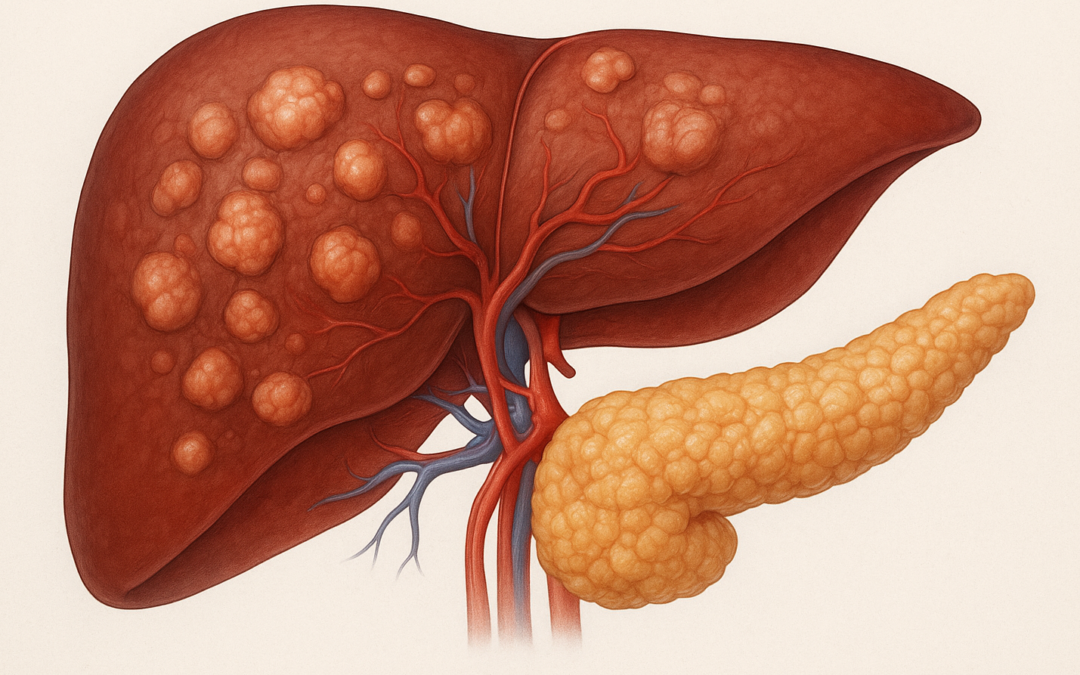
Chagas disease, caused by Trypanosoma cruzi, is a leading cause of non-ischemic cardiomyopathy in Latin America, affecting 6–7 million people. Despite clear benefit of sacubitril/valsartan over enalapril in HFrEF of other etiologies (PARADIGM-HF trial), its efficacy in Chagas cardiomyopathy remained unknown due to distinct pathophysiology involving chronic inflammation, fibrosis, and microvascular dysfunction.

Endometrial cancer (EC), particularly the endometrioid subtype, remains a leading gynecologic malignancy with limited options for advanced, ER-positive disease. Preclinical models demonstrate synergistic antitumor effects from concurrent inhibition of estrogen receptor (ER), cyclin-dependent kinase 4/6 (CDK4/6), and phosphoinositide 3-kinase (PI3K)/mammalian target of rapamycin (mTOR) pathways. Building on window-of-opportunity studies showing metformin’s suppression of PI3K/mTOR signaling in EC, we conducted a single-arm, non-randomized phase 2 trial (NCT03675893) to evaluate the combination of letrozole (an aromatase inhibitor), abemaciclib (a CDK4/6 inhibitor), and metformin (a PI3K/mTOR modulator) in patients with ER-positive endometrioid EC.

Hypertension remains a global health crisis, affecting over 1.4 billion people and serving as a leading risk factor for cardiovascular and renal diseases. Despite advances in antihypertensive therapies, approximately 50% of treated patients in the US fail to achieve blood pressure control with multiple agents, highlighting a critical unmet need in hard-to-control (uncontrolled or treatment-resistant) hypertension. Aldosterone, a hormone that promotes sodium and water retention, plays a pivotal role in this resistance, yet targeted interventions have been limited for over two decades.

Type 2 diabetes (T2D) in Asian Indians is characterized by high ectopic fat deposition in liver and pancreas, elevated Fetuin-A (an insulin resistance mediator), and hepatic fibrosis risk. While SGLT2 inhibitors like Dapagliflozin (DAPA) reduce hepatic and pancreatic fat, Metformin’s effects on these parameters, especially Fetuin-A and fibrosis, remain underexplored in this population.

Obesity, defined by WHO as BMI ≥30 kg/m² in adults, has escalated into a global epidemic, impacting over 1 billion individuals and contributing to 3.7 million deaths in 2024 alone. Projections indicate a doubling of prevalence by 2030, fueling noncommunicable diseases such as cardiovascular conditions, type 2 diabetes, and certain cancers, while exacerbating infectious disease outcomes. Economic burdens are forecasted to reach US$3 trillion annually by 2030. Glucagon-like peptide-1 receptor agonists (GLP-1 RAs)—including liraglutide, semaglutide, and tirzepatide—have emerged as efficacious pharmacological options, promoting weight loss, glycemic control, and reductions in cardiovascular and renal risks, alongside lowered mortality in diabetes. In September 2025, WHO added select GLP-1 RAs to the Essential Medicines List for high-risk type 2 diabetes management. Responding to Member State requests, this inaugural WHO guideline on GLP-1 RAs for obesity treatment emphasizes their role within a comprehensive, person-centered framework incorporating diet, physical activity, and psychosocial support, aligning with the 2022 Acceleration Plan to Halt the Rise in Obesity.

Topiramate (TPM), a sulfamate-substituted monosaccharide, is a broad-spectrum anticonvulsant widely prescribed for epilepsy, migraine prophylaxis, and neuropathic pain. Its therapeutic efficacy stems from multifaceted interactions with ion channels, neurotransmitter receptors, and enzymes; however, the precise mechanisms governing its modulation of plasmalemmal ionic currents—particularly voltage-gated sodium currents (I_Na) and hyperpolarization-activated cation currents (I_h)—remain incompletely characterized. Prior studies have implicated TPM in sodium channel blockade, yet inconsistencies persist regarding concentration-dependent effects, gating kinetics, and interactions with other currents. This study employs patch-clamp techniques in GH₃ rat lactotrophs, an established model for excitable cells, to provide comprehensive evidence of TPM’s “dual block” on I_Na and I_h, elucidating potential contributions to its neuromodulatory profile.

Chronic spontaneous urticaria (CSU) affects approximately 270,000 adults and adolescents aged 12 and older in the European Union, manifesting as unpredictable outbreaks of debilitating hives and intense itch that disrupt daily life. For many, standard first-line treatments like H1 antihistamines provide insufficient relief, leaving patients in cycles of discomfort and frustration. In a landmark development, Sanofi and Regeneron Pharmaceuticals have secured European Commission approval for Dupixent (dupilumab), marking the first targeted biologic therapy for moderate-to-severe CSU in over a decade.

Tirzepatide, a dual GLP-1/GIP receptor agonist, induces substantial weight loss and cardiometabolic improvements in adults with obesity. However, the SURMOUNT-4 trial demonstrated that most participants regain weight upon discontinuation, raising questions about the durability of associated health benefits. The objective is to evaluate changes in cardiometabolic parameters stratified by the extent of weight regain following tirzepatide withdrawal in the SURMOUNT-4 trial.

Sacubitril/valsartan, an angiotensin receptor-neprilysin inhibitor (ARNI), has revolutionized heart failure with reduced ejection fraction (HFrEF) management since its 2015 approval, demonstrating superior efficacy over ACE inhibitors in the PARADIGM-HF trial. However, real-world safety concerns, particularly regarding angioedema and renal effects, necessitate post-marketing surveillance. This study conducts a disproportionality analysis using the FDA Adverse Event Reporting System (FAERS) database to compare adverse drug events (ADEs) between sacubitril/valsartan and valsartan monotherapy, aiming to detect pharmacovigilance signals and guide clinical decision-making.

Advanced cardiovascular imaging plays a pivotal role in diagnosing, risk-stratifying, and managing a spectrum of cardiac conditions, from ischemic heart disease to cardiomyopathies and valvular disorders. However, rapid technological evolution—spanning echocardiography (echo), cardiovascular computed tomography (CCT), cardiovascular magnetic resonance (CMR), and nuclear cardiology—demands rigorous, standardized training to ensure competency and patient safety. The 2025 Advanced Training Statement on Advanced Cardiovascular Imaging, jointly authored by the American College of Cardiology (ACC), American Heart Association (AHA), American Society of Echocardiography (ASE), American Society of Nuclear Cardiology (ASNC), Society of Cardiovascular Computed Tomography (SCCT), and Society for Cardiovascular Magnetic Resonance (SCMR), and issued by the ACC Competency Management Committee, addresses this need by updating prior frameworks to reflect contemporary practice.











